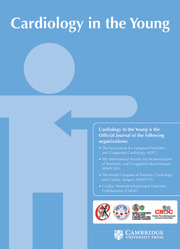No CrossRef data available.
Article contents
Alterations in the intestinal microbiome and immune dysregulation in infants with CHD undergoing cardiopulmonary bypass: a scoping review
Published online by Cambridge University Press: 14 February 2025
Abstract
Infants who require cardiopulmonary bypass for surgical repair of CHD are at high risk for secondary infections, which cause significant death and disability. The risk of secondary infection is increased by immune dysfunction. The intestinal microbiome calibrates immune function. Infants with CHD have substantial changes in their intestinal microbiome. We performed this scoping review to describe the current understanding of the relationship between the intestinal microbiome and immune function after pediatric cardiac surgery with cardiopulmonary bypass.
We searched the PubMed, Cumulative Index to Nursing and Allied Health Literature, Cochrane, and Scopus databases with the assistance of a medical librarian. We included trials that analysed intestinal microbiome composition and immune function after cardiac surgery with cardiopulmonary bypass in infants.
We found two observational cohorts and two interventional trials describing composition of intestinal microbiome and some measures of immune function after heart surgery with cardiopulmonary bypass in infants. A total of 114 children were analysed. Three trials were exclusively in infants, and one was in older children and infants. All trials found a differential composition of the intestinal microbiome in infants with CHD compared to those without CHD, and one described a robust correlation between composition of the intestinal microbiome with cytokine profile and adverse outcomes.
Despite robust preclinical data and data from other disease states, there is minimal data about the correlation between immune function and intestinal microbiome composition in infants with CHD after cardiopulmonary bypass.
- Type
- Review
- Information
- Copyright
- © The Author(s), 2025. Published by Cambridge University Press



